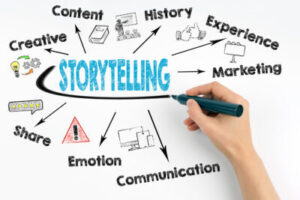Whether you are writing copy for a direct response mail order campaign, an email autoresponder sequence, or an online sales letter – you need to understand the fundamentals of copywriting in order to get the best results.
There’s no better way to do this than to study from the very best. There are some great copywriters that have graced the advertising world and some of them have shared their wisdom in books. If you want to know how to write effective sales copy then you need to read and study several books on the subject. The more books you study the better, as each writer has their own unique style and lessons to share.
I have reviewed some of the best copywriting books on the market, written by some of the legends in the game who were able to constantly achieve outstanding success as a result of their ability to write excellent copy.
These books are suitable for both beginners and pros. They are not ranked in any particular order – if they are on the list they are all worth reading.
Here’s a summary of the list:
- The Boron Letters – Gary Halbert
- The Adweek Copywriting Handbook – Joseph Sugarman
- Scientific Advertising – Claude C. Hopkins
- The Ultimate Sales Letter – Dan Kennedy
- Breakthrough Advertising – Eugene Schwartz
- Cashvertising – Drew Eric Whitman
- Copywriting Secrets – Jim Edwards
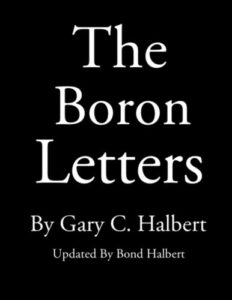 1. The Boron Letters – Gary Halbert
1. The Boron Letters – Gary Halbert
Gary Halbert is widely regarded as one of the best copywriters to have ever lived.
His sales letters and campaigns have gone on to make billions of dollars in a variety of industries and his approach to copywriting has been imitated and adopted by copywriters all over the world.
Gary is attributed to having the most widely mailed sales letter in history – a letter that has been allegedly mailed to every home in America at least 3 times!
There is a saying in the copywriting world: “All roads lead to back to Gary Halbert”.
Gary has inspired some of the biggest names in the industry today – including Dan Kennedy, Jay Abraham, and John Carlton to name just a few.
The Boron Letters is not a conventional “How To” book. It’s actually a series of letters Gary wrote to his son Bond whilst Gary was in Boron prison. The letters were Gary’s way of sharing his copywriting and marketing wisdom with his son, but they also contain lessons on health, diet, exercise, and well-being as he considered these factors to be just as critical to a copywriter’s success.
You’ll find much wisdom in these letters that’ll help you not only improve your marketing results but also how to improve other aspects of your life.
He touches on identifying a “starving crowd” of prospects and how you can position your product or offer to appeal to their demands. He also mentions the importance of being a student of markets, the AIDA model, split-testing your copy regularly, including calls-to-action in your ad, and much more.
It’s a fascinating read written by one of the modern-day greats. It’s even more fascinating when you think of the conditions under which he wrote these letters.
His son Bond has updated the book and added his own commentary to each letter to explain what his father was referring to in certain parts, and also to explain what the letters meant to him. The Boron Letters is a unique book that blends copywriting insight, marketing tactics, and personal self-improvement tips, all told in Gary’s inimitable style.
It contains sound advice on how to handle obstacles, not only in the world of direct response copywriting but in life.
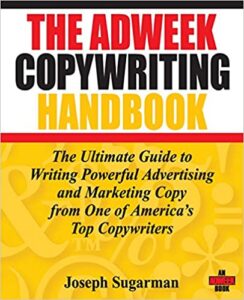 2. The Adweek Copywriting Handbook – Joseph Sugarman
2. The Adweek Copywriting Handbook – Joseph Sugarman
Joseph Sugarman is a legend in the world of direct response copywriting and marketing industry.
He pioneered some of the sales strategies still used to this day, including the idea of a toll-free number, and the acceptance of credit card payments by phone. His sales copy has helped to sell millions of units of different products – from digital watches, cordless phones, pocket calculators, and more.
Sugarman gave a series of lectures and seminars during the 1970s and this book is based on many of those core lessons. The great thing is that many of those principles and best practices still apply today – regardless if you are selling online or via direct response mail.
This is a real handbook in every sense of the word. It is structured in such a way that makes it easy to follow and provides a step-by-step approach to learning and improving your copywriting skills.
Sugarman covers everything from the importance and purpose of headlines, how to lay out your ads, the psychological triggers that influence buying behaviour, sentence length, and much more.
This book is essentially a copywriting manual and contains the do’s and don’ts of copywriting to make sure you are able to get the best ROI on your advertising campaigns and maximise sales.
He also includes tons of examples of his successful ads and breaks them down so you can see how and where he has applied these principles. There is a section of the book that focuses purely on the different types of marketing channels and how they can be utilised effectively.
This is a comprehensive book on copywriting, and at over 300 pages, it’s chock-full of actionable insights, tips, and tricks that’ll turn you into a confident copywriter in no time.
It is structured in such a way that makes it easy to follow and provides a step-by-step approach that makes it easy for you to learn and improve your copywriting skills.
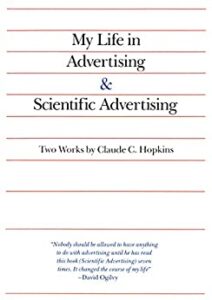 3. Scientific Advertising – Claude C. Hopkins
3. Scientific Advertising – Claude C. Hopkins
Claude C. Hopkins is one of the more famous “old school experts” of the advertising world.
In 1923 he wrote his seminal work “Scientific Advertising” which has now become a classic and is considered one of the most important works on the subject.
In the Boron Letters, Gary Halbert recommends that his son buy a copy of Scientific Advertising and read it at least 3 times over.
David Ogilvy was also keen to praise Hopkin’s work. Ogilvy wrote that “Nobody should be allowed to have anything to do with advertising until he has read this book seven times. It changed the course of my life.”
That’s how highly regarded this book is. As the title of the book suggests, Claude Hopkins firmly believed that advertising, when done correctly, is an exact science that is “based on fixed principles“.
In this enjoyable, no-nonsense book Hopkins explains those principles. He stresses the importance of understanding your target buyer and catering to their needs. This may sound obvious today, but back in Hopkins’ day advertisements were mostly ego boosters for companies and brands to toot their own horns and sing their own praises – they paid little attention to the deeper needs of their target audience.
Hopkins also recognised the importance of not criticising rival products or competitors to boost your own credibility, as it reflects badly on your own brand in the long run.
There are chapters dedicated to psychology, writing effective headlines, testing, storytelling, and strategy.
It is written in a straightforward, easy to read manner with golden nuggets found in almost every paragraph. This version of the classic also comes with Hopkin’s autobiography – “My Life In Advertising”, which is also a great read, so you’re getting two books for the price of one.
Scientific Advertising is a timeless classic and the lessons outlined in it are still as relevant today as they were when he first wrote them. This is an essential addition to the library of anyone serious about improving their advertising and copywriting skills.
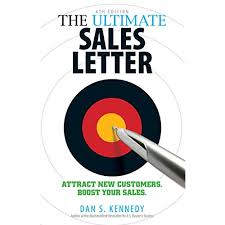 4. The Ultimate Sales Letter – Dan Kennedy
4. The Ultimate Sales Letter – Dan Kennedy
Dan Kennedy is well known for his “No B.S” series of books which cover everything from business success, direct response marketing, and sales copywriting.
He is one of the modern-day experts in the field, and this book is a goldmine of information and insights for anyone that wants to improve their ability to write high converting sales letters.
Although this book focuses on traditional sales letters intended for direct mail, the timeless principles and concepts Dan outlines can still be used today for online marketing, online sales pages, emails, and video sales letters.
Although there are some parts of this book that will seem a bit outdated – like the mention of fax machines (remember those?!), the theory is still sound and relevant today.
The content you need to put in your sales letters is the same today as it was then, regardless of the format it takes.
He explains the writing process, talks about the importance of editing and re-editing, gives tips on how to get your sales letter read, and talks about the power of adding a “P.S” at the end of each letter. Dan talks about the power of having the right sequence in your sales copy, and how you can use your sales letters to create the maximum value for your business and your clients.
What I love about this book is that Dan also includes lots of examples of some of his most successful sales letters, so you get to actually see how he applied his own teachings to engage readers, make more sales, and bring in more cash.
There are many valuable lessons and insights in this book, and although it’s a bit dated in places, the fundamental lessons are evergreen and still hold true.
If you want a quick, easy to follow and implement guide on how to craft powerful sales letters then you can do a lot worse than getting this book.
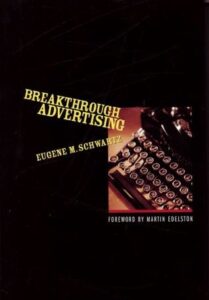 5. Breakthrough Advertising – Eugene Schwartz
5. Breakthrough Advertising – Eugene Schwartz
This is the most expensive book on the list, currently selling anywhere from $125 or more! Yes, you read that price right.
Because of a limited print run getting a copy of this book is not easy unless hence it’s hefty price-tag.
Schwartz first published this book in 1966, but the content it holds within its costly pages is worth their weight in gold if you study and apply them. This book is loaded with tips, techniques, and principles that will make your advertising messages irresistible to your readers.
You’ll learn how to write headlines that grab your prospect’s attention and keep them enraptured so that they want to keep reading your sales copy all the way to the end.
Eugene emphasizes the need to truly understand your prospects and to create advertising campaigns that appeal to them on an emotional level by addressing their needs, fears, and desires.
He teaches the reader how to create copy that can speak to the most basic instincts of your prospects and create impulse sales. Eugene’s writing style is clean, straight to the point, and no-nonsense. His words still resonate with readers today just as they did when this was first published.
This is an expensive book no doubt, but the priceless gems of wisdom you get within its covers will more than pay for themselves if you study the material and put it to good use.
Don’t overthink this one – buy this book, read, it, and treasure it!
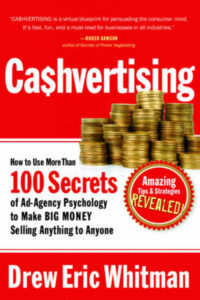 6. Cashvertising – Drew Eric Whitman
6. Cashvertising – Drew Eric Whitman
In this explosive book, Whitman blows the lid off some of the advertising industry’s deepest secrets and most effective strategies.
He takes the reader down the rabbit hole of psychological advertising and delivers knockout punch after knockout punch.
Whitman talks about the 8 primary human desires, which he calls the Life-Force 8. He explains that all humans are biologically hard-wired with these 8 desires, and teaches you how to appeal to them in your advertising in order to easily establish rapport and trust with your customers, and ultimately make more sales.
He also identifies 9 secondary or learned wants that operate in the background of our minds, and which play second fiddle to the primary 8. By skillfully appealing to these different desires, the successful advertiser can create a drive within their prospect that motivates them to take action to fulfill that desire immediately.
When you are able to create that desire and have your product serve as the fulfillment of that desire you will sell a lot of products….and make a lot of cash! This is some powerful stuff.
Drew explains the power of words, and how to use the right word at the right time to create specific mental images in the minds of your prospects.
He teaches the 17 foundational principles of consumer psychology and backs everything up with lots of data and examples that make this book an interesting read.
Despite the deep content, Cashvertising is an easy-to-read book that manages to explain many different concepts in a way that makes them easy to understand and apply. If you manage to apply just a few of the many tips, tricks, and suggestions Whitman gives you, you’re sure to have some huge successes with your copywriting and advertising campaigns.
Once you start reading this book you may find it hard to put down…..damn Drew Whitman is good!
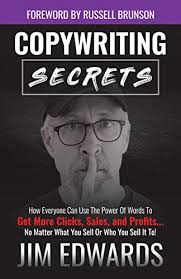 7. Copywriting Secrets – Jim Edwards
7. Copywriting Secrets – Jim Edwards
This is the most recent publication on the list.
Jim Edwards is best known for working with Russell Brunson, the founder of the software ClickFunnels. Jim created an application for ClickFunnels called Funnel Scripts which is essentially a plug-and-play copywriting tool that can create headlines and copy by answering certain questions about your product or service.
Before that, he worked as a successful copywriter before venturing out on his own and using his knowledge to sell millions of dollars worth of products online.
Unlike the other books in this review, Copywriting Secrets is written with internet marketing first in mind, although the concepts and lessons within can be applied to any medium.
This book is great if you’re an online marketer looking for something that is specific to the world of digital marketing. But it is also equally as good if you’re looking to improve your direct response marketing or write sales copy for offline channels.
Whether you are promoting webinars, selling digital information products, selling physical goods or services, or doing affiliate marketing – this book gives you a great overview of how to create good sales copy throughout all stages of the customer journey. You’ll learn some really cool copywriting hacks, and Jim shares some great examples so you can see these tips in action.
At the start of each chapter, Jim shares a quote from some of the great copywriters such as Gary Halbert, David Olgivly, Robert Collier, Eugene Schwartz, and even people like Napoleon and Leonardo Da Vinci.
You’ll learn why people buy, how to write attention-grabbing headlines and effective bullet points, and how to craft killer email teasers.
Edwards explains stealth closes – how to sell without selling, and details the best way to create customer avatars so you can get inside your customer’s heads and understand them better.
He also explains concepts like hot, warm, and cold traffic, and guides you through how to write copy that appeals to each type of traffic to improve your click through rates, number of subscribers, sales, ROI, and conversion rates.
The book is a great read. It’s easily digestible and even has stick figure cartoons throughout to illustrate points and add a dimension of wit and fun.
Why it’s important to keep studying
Copywriting skills are like muscles – the more you use them the stronger they become.
Being able to write great sales copy and high converting adverts can become as natural to you as breathing, but only if you are willing to put in the work. You have to study the lessons of those who have been there and done it and put those lessons into practice.
Once you’ve tested them – keep what works and tweak what doesn’t to see if you can improve on the result. You should also continuously tweak and test your winning copy to see if you can better its performance. The best marketers are those that are constantly learning, testing, and re-testing.
By constantly testing and re-testing you’ll improve your copywriting ability and style, and you’ll develop a writing “muscle memory” which will enable you to constantly churn out great copy for your business and your clients.
You’ve heard of the old sales maxim ABC – Always Be Closing. Well, I like to say that every good marketer should ABT – Always Be Testing. Test everything you read in these books and make these strategies, hacks, and principles a part of your copywriting arsenal. When you do, you’ll find your results will improve – and as long as you keep studying and applying what you learn they’ll keep on improving.
Check out my top 5 copywriting tips that I’ve learned from some of these books and start putting them into practice now.




